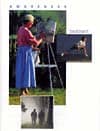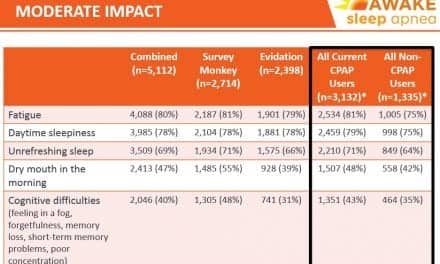Vestibular Disorder Connection

Though the vestibular system in humans is primitive, it is, nonetheless, essential for functioning in earth’s gravitational field. Considerable animal research on vestibular function during sleep has been completed,1 but relatively little work has been done in humans. Interest in the potentially important relationship between vestibular and sleep disorders arose coincidentally in the course of evaluating patients with perilymph fistula (PLF) syndrome for sleep apnea. Preliminary case series results have previously been reported.2,3
PLF syndrome is both an acute and a chronic disorder arising from physical trauma (minimal, at times) to the head and/or neck, resulting in disruption of the round or oval windows. PLF is an abnormal communication between the inner and middle ear cavities. Long-term symptoms include not only the expected dysequilibrium, headache, and hearing loss, but also substantial cognitive and mood dysfunction. Though considerable progress has been made in its identification, it often goes unrecognized or is given a psychogenic pathogenesis. Diagnosis rests on clinical suspicion and confirmatory neuro-otological testing, especially the moving-platform posturography fistula test. Management centers on prolonged bed rest and, at times, surgical repair of the defect.4 Early identification and control are essential because of the often profoundly disabling nature of the syndrome and the potential for irreparable hearing loss and permanent imbalance.
Case One
A 55-year-old male was seen for evaluation on April 6, 2000, by the Pacific Sleep Program, Portland, Ore, for possible sleep apnea syndrome and fatigue. In May 1999, he had been injured in an automobile accident in which the car that he was driving was struck from behind by another traveling at approximately 95 km per hour. He experienced a momentary lapse in alertness, but most notable was the development of right-sided hearing loss, accompanied by a feeling of dizziness, disorientation, attention and concentration problems, and short-term memory loss. He was seen for a neuro-otological consultation, underwent vestibular testing, and was found to have bilateral PLF along with accompanying hearing loss.
Although he had exhibited snoring before his accident, it was both minor and intermittent. Premorbidly, there were no significant sleep-related or alertness-related problems. Since the accident, his sleep onset had remained normal and he denied any significant abnormal hypnagogic symptoms. He felt as if he slept reasonably soundly, but his bed partner reported that he had developed consistent, loud snoring and, possibly, interrupted breathing. The patient admitted that occasionally he awoke gasping. Sleep had become nonrestorative, and he experienced widespread myalgias; in addition, he usually experienced tinnitus and a wet sensation in his right ear. During his waking hours, he was experiencing increasing fatigue, along with continued concentration and short-term–memory disturbances that made it difficult for him to work effectively as a high-level manager for a computer services business. He denied overt, abnormal daytime sleepiness.
He had been gaining weight gradually over a number of years and was found to have hypertension as well. He rarely consumed alcohol and there was no substance abuse. He did not smoke and was not taking medication. His weight at the time of evaluation was 120 kg and his body mass index (BMI) was 33.5. He looked quite fatigued, and his neurological examination was benign except for bilateral hearing loss, along with a marginally abnormal tandem Romberg sign. He showed a moderately reduced oropharynx with large tongue and palate with significant lateral narrowing.
Shortly after this evaluation, he underwent diagnostic polysomnography. This revealed severely disrupted sleep in which he awoke 39 times, 7.3% rapid–eye-movement (REM) sleep, 62 arousals per hour, and moderately loud snoring. His respiratory disturbance index (RDI) was 63/hour, consisting of obstructive apneas and hypopneas; his maximum oxygen desaturation level was 69%. Within a week, he underwent therapeutic polysomnography. Treatment was initiated with nasal continuous positive airway pressure (CPAP), which was changed to bilevel positive airway pressure when the CPAP level reached a point that was thought to be possibly otologically detrimental. This treatment was successful in eliminating both snoring and respiratory disturbances at an inspiratory pressure of 12 and an expiratory pressure of 3 cm H2O in spontaneous mode. A substantial improvement in sleep quality was exhibited: only five awakenings, an arousal rate of 14.1 per hour, and 21.9% REM sleep. The next morning, the patient felt extraordinarily well, the wet sensation in his ear had disappeared, and his tinnitus had abated.
In the year since the initiation of treatment, he has remained fully compliant. All of his sleep related-problems have disappeared, along with his fatigue and cognitive disturbances. Tinnitus disappeared entirely, his fistulae closed without surgery, and dizziness was markedly diminished (and only rarely troublesome).
Case Two
A 54-year-old male was seen for consultation by the Pacific Sleep Program on April 5, 2001, for possible sleep apnea syndrome. Approximately 2 months before first being seen, he had experienced a minor head injury while engaged in recreational activity. This left him feeling mildly dazed for a few hours, with transient left-ear discomfort. He developed severe dizziness 2 to 3 weeks later, accompanied by diminished attention and concentration, short-term memory problems, and visual blurring. He was seen for neuro-otological consultation, underwent vestibular testing, and was found to have bilateral PLF.
He had exhibited intermittent, low-level snoring before his accident. Prior to the emergence of his vestibular symptoms, there were no significant sleep-related or alertness-related problems. Since the accident, his sleep onset had remained normal and he denied any significant abnormal hypnagogic symptoms. He recalled usually having a single, brief awakening of uncertain precipitance. His bed partner reported that he had developed consistent, loud crescendo snoring and (possibly) interrupted breathing. He also occasionally awoke gasping. He continued to arise early (as was his habit), somewhat less rested than he had previously felt. He usually felt quite dizzy upon awakening. During his waking hours, he was experiencing increasing fatigue along with continued concentration and short-term–memory disturbances. His difficulty during the day had reached such an intensity that he believed his position as a high-level executive for a large national company was in substantial jeopardy. He denied overt, abnormal daytime sleepiness.
His weight had been stable over the years. There was little alcohol consumption and no evidence of any substance abuse. He did not smoke, and hypertension had been diagnosed the year before he was seen. His only medications were for cholesterol and blood-pressure management. His weight at the time of evaluation was 84 kg, and his BMI was 26. When seen for consultation, he looked rested, but was mildly depressed. His neurological examination was benign, except for an abnormal tandem Romberg sign. He showed a prominently left-deviated nasal septum and reduced oropharynx with a Mallampati index of 3, a moderately webbed palate, a large tongue, and lateral narrowing.
Shortly after evaluation, he underwent split-night polysomnography. This revealed disrupted sleep during the diagnostic phase of the recording, during which he slept 2.1 hours (awakening 16 times), had 29 arousals per hour, and snored loudly and consistently. His diagnostic RDI was 18.7 per hour. These consisted of obstructive apneas and hypopneas and a number that suggested more subtle upper-airway resistance episodes. The maximum oxygen desaturation level was only 91%.
Treatment was initiated using nasal CPAP, which was successful in eliminating both snoring and respiratory disturbances at 7 cm H2O. Sleep quality improved, and the patient felt significantly better. For the first time since his problems had begun, his dizziness in the morning was markedly reduced, although he still experienced some tinnitus.
Over the past 3 months, he has been followed closely. He has adapted well to treatment with nasal CPAP without complication and has been fully compliant. Neither snoring nor apnea has been noted. He feels much more rested, recognizing that he had been more fatigued than he had originally realized. His cognitive function has returned to normal, and he feels that he has returned to his prior level of function at work. His neuro-otologist communicated that his fistulae appeared to be healing, and it was unlikely that operative intervention would be required.
Discussion
These two cases demonstrate the impact that sleep apnea syndrome may have on PLF syndrome, in both relatively acute and more chronic situations. The elimination of respiratory disturbances was, in both cases, associated with immediate improvement in vestibular symptomatology; this was sustained and associated with further improvement of a degree sufficient to avoid the operative closure of the fistulae (otherwise so often necessary). These cases also demonstrate that not only is severe sleep apnea important, but a much milder level may have a substantial impact on the vestibular disorder. PLF disorders are often initially treated with bed rest, minimizing the pressure fluctuations that may prevent spontaneous closure. It is interesting that both of these patients improved without that although this is certainly not always the case. F. Owen Black, MD, a local neuro-otologist with a special interest and expertise in PLF syndrome, has concluded that one important reason for the failure of spontaneous closure or operative intervention is sleep apnea syndrome. The association is so strong that individuals with this vestibular disorder, and in whom sleep apnea is also suspected, undergo expedited evaluation and treatment for their sleep apnea before primary, corrective vestibular intervention.
Both spontaneous and clearly posttraumatic PLFs have been described. Goodhill5 was the first to propose that either implosive or explosive directions of force could produce the abnormal communications. The explosive route produces disruption by means of the transmission of changes in intracranial pressure to the perilymphatic space through a patent cochlear aqueduct in those individuals in whom this exists or the internal auditory canal; perilymph then flows into the middle ear cavity. The implosive route transmits air pressure from the nasopharynx through the eustachian tube, producing an inward rupture. It is thought that volume shifts produce the hearing alteration and imbalance. Both snoring and obstructive apnea are known to produce wide swings in pressure in the nasopharynx; this may be one mechanism through which sleep apnea syndrome prevents the closure of fistulae. Obstructive apneas can also produce changes in intracranial pressure that can be dramatic in degree.6-8 These fluctuations are thought to affect PLF by means of the explosive route.
The mechanism through which positive airway pressure improves PLF symptoms, as well as promoting healing, is probably the elimination of both forms of pressure fluctuation. We have, further, found that patients will respond better, and avoid a rare actual worsening of their symptoms, if the expiratory pressure remains below 10 cm H2O. The treatment-associated pressure levels are generally far lower than those associated with individual apneic events. Thus, bilevel positive airway pressure is often employed. The use of the lowest possible expiratory pressure is probably influential from both internal and external force directions.
It is important to add vestibular disorders to the growing list of medical conditions affected by sleep apnea syndrome. A growing number of patients are being seen by the Pacific Sleep Program who have other vestibular disorders, particularly Meniere syndrome. When they also have sleep apnea, its correction has been followed by improvement in the vestibular disorder. This suggests a broader impact of obstructive apnea on vestibular function and disorders. In addition, it is important that both sleep medicine professionals and clinicians providing care to patients primarily for their vestibular disorder recognize the importance of this relationship.
Finally, these two cases, along with those of other patients that we have seen, raise questions about the potential importance of the vestibular system in the pathogenesis of obstructive sleep apnea syndrome. Furman et al9 have recently reviewed involvement of the vestibular system in autonomic control, including references to the involuntary control aspects of respiration. The central importance of tongue position in the pathogenesis of sleep apnea is widely known. Elmund et al10 investigated what they concluded to be important indirect, polysynaptic connections between vestibular end organ and hypoglossal motor neurons in cats, describing a vestibulolingual effect influencing tongue posture. Yates and Rossiter11 studied the effect of selective peripheral labyrinthine vestibular stimulation on hypoglossal nerve activity in cats and found a substantial impact that was particularly strong for otolithic receptors and weaker for canal afferents. The discovery of obstructive sleep apnea syndrome in PLF-disorder patients appears to be the first linking of a vestibular disorder in humans, research on vestibular physiological influences on tongue position in animals, and upper-airway obstruction during sleep. The emergence of apnea in PLF patients could arise directly from peripheral end-organ damage and/or related central neural processing dysfunction, perhaps at the level of the vestibular nuclei. Weight is not a sufficient cause in these cases, with case two being of nearly normal weight, but it certainly may be of import in the intensity of objective apnea associated with PLF disorder, as it is in other cases. Upper-airway anatomy that renders an individual vulnerable to apnea may need to be present for sleep apnea syndrome to emerge in these cases, but it is not possible to draw conclusions in this regard at this time. Other proprioceptive or autonomic influences may also turn out to be important elements.

References:
1. Pompeiano O. Vestibular influences in sleep. In: Vinken PJ, Bruyn GW, eds. Handbook of Clinical Neurology. Amsterdam: North-Holland; 1975: 583-622.
2. Rich GB, Black FO, Grimm RJ. Sleep disturbances, the vestibular system and perilymph fistula. Paper presented at: Advances in Sleep Medicine, Winter Meeting; February 1996; Aspen, Colo.
3. Rich GB. Sleep disorders, the vestibular system and perilymph fistula syndrome. Sleep Research. 1998;27:58.
4. Grimm RJ, Hemenway WG, LeBray PR, Black FO. The perilymph fistula syndrome defined in mild head trauma. Acta Otolaryngol. 1989;464:S1-S36.
5. Goodhill V. Sudden deafness and round window rupture. Laryngoscope. 1971;81:1462-1474.
6. Sugita Y, Iijima S, Teshima Y, et al. Marked episodic elevation of cerebrospinal fluid pressure during nocturnal sleep in patients with sleep apnea hypersomnia syndrome. Electroencephalogr Clin Neurophysiol. 1985;60:214-219.
7. Jennum P, Borgesen S. Intracranial pressure and obstructive sleep apnea. Chest. 1989;95:279-283.
8. Rich GB. Review of paper: Papilledema and obstructive sleep apnea syndrome. Sleep Med. 2001;2:259-261.
9. Furman JM, Jacob RG, Redfern MS. Clinical evidence that the vestibular system participates in autonomic control. J Vestib Res. 1998;8:27-34.
10. Elmund F, Bowman JP, Morgan RJ. Vestibular influence on tongue activity. Exp Neurol. 1983;81:126-140.
11. Yates BJ, Rossiter CD. Vestibular influences on hypoglossal nerve activity in the cat. Neurosci Lett. 1996;211:25-28.



